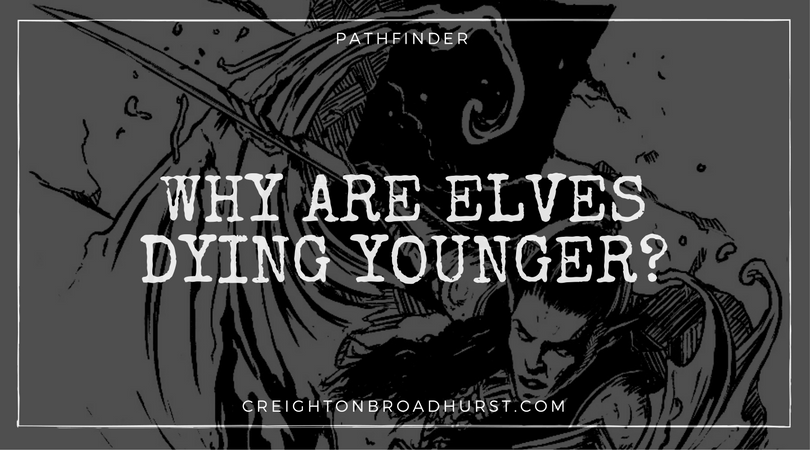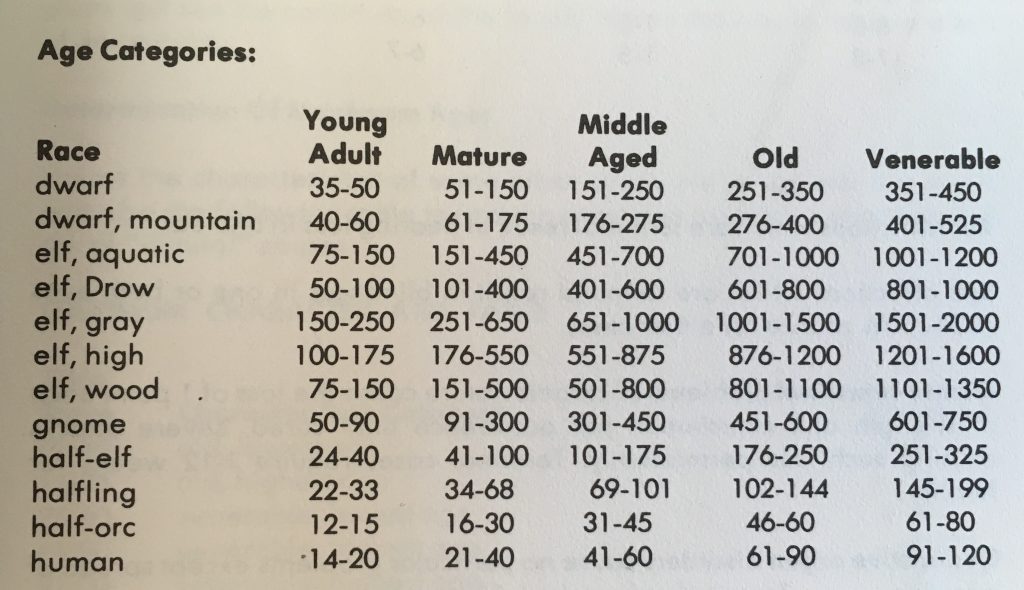I noticed an intriguing thing the other day, while continuing my design of Gloamhold. Elves are dying at a much younger age than ever before! The horror! What’s going on

I don’t mean there is some kind of conspiracy against elves (or is there?) It just seems that since 1st Edition, their maximum age has dropped precipitously. Consider these maximum ages, in 1st Edition AD&D as listed in the 1st Edition AD&D DMG (surely the greatest gaming book of all time):
Elves could be staggeringly old. I distinctly remember thinking it was so cool there were elves alive in the present day Flanaess that probably witnessed the Twin Cataclysms and the chaos and upheaval of the ensuing Great Migrations.
Now, here are the maximum ages as listed in the Pathfinder Core Rulebook:
See what I mean?
Further analysis reveals the maximum age of an elf through the editions:
- 1st Edition: 2,000 years old
- 2nd Edition: 750 years old (but note at this age, the elf does not die but rather has a mysterious compulsion to depart the world of men)
- 3rd Edition: 750 years old
- Pathfinder: 750 years old
- 5th Edition: “Well over” 700 years
Bizarrely, gnomes and half-elves suffer a similar reduction in life expectancy while dwarves, half-orcs and halfings do not.
I wonder why this is? I can’t see how it relates to game balance.
World Design
I can see an argument in relation to world design, but given the “cinematic” game play style of Pathfinder (and later editions of D&D), I can’t image this was viewed as a huge problem.
That said, it’s very hard to build a deep, meaningful and yet mysterious world history if elves are so long-lived some still alive remember when humanity founded its first city or kingdom. To use an example from the real world, Ur—an ancient Sumerian settlement—was founded around 3,800 BC. That’s only 6,000 years ago give or take—within the lifetime of three (or four) generations of grey elves.
Character Design
I guess the other argument could be one of character design. In a world with skills, skill points (or ranks), feats and suchlike it’s quite hard to justify why an elf wizard of 160 years has the same number of skill points (and thus knowledge) at 1st-level as a 26-year-old human wizard. And—of course—if they do get extra skills and suchlike, why would anyone play a human or other short-lived race?
What Do You Think?
While a race’s maximum age probably won’t impact the average adventurer, I’d love to know the “official” reason behind the change. At the end of the day, there must have been a reason to reduce the maximum ages—I doubt it was done on a whim.
In any event, what have I missed? Let me know, in the comments below!



Of course a world can be mysterious if there are thousand year old elves!
Just because there are people who were alive in a particular time doesn’t mean that they know what happened everywhere in that time.
Even if they were eyewitnesses to or protagonists in past events, that doesn’t mean they’ll talk about it to PCs or give an accurate account if they do. Millennia old beings suffer from bias too. And being the only living witness to monumental events gives you a lot of “editorial” control over the version of history that gets remembered and recorded. Ancient elves are fantastic unreliable narrators, able to use their account of history to shape current events and enmities based on their own biases and prejudices (“The dwarves are our most ancient and treacherous enemy. They started this centuries-long war. I know, I was there when they struck the first blow.”) .
There are a lot of ways to keep elves and other long lived races on a par with humans skill-wise (though no idea why aging comes into it, aside from some desire to clear the NPC decks for obscure world-building reasons) – but IMO long-lived races should be terrifyingly skilled (though this might make them unplayable in some mixed parties in D&D and PF). Equally, short lived races (like gnolls and thri-kreen to pick particular examples) should get less skill points.
The Mythras system (formerly Runequest 6) gives bonus skill points to characters according to their age. Recently, I increased the bonus points for long-lived D&D fantasy races, and reduced the bonus points for short lived ones to see what you’d get. It seemed to produce the kind of gnomish master craftsmen, or dwarvish legendary armourers, or terrifying elflords that you see in a lot of fantasy fiction. Similarly, for the short lived races to be effective, they need to use natural advantages (for example, stealth, poison, terrain etc), or overcome superior enemies with tactics or weight of numbers. The Mythras combat system models this well – even an elf blademaster with 120% combat skill has a limit to their action points in a round, and can be quickly overborne by superior numbers, or a hail of missiles (esp. if they don’t have a shield!).
By any chance, were you playing that bladesinger? 😉
I was not actually. 🙂
I can’t wait for Gloamhold episodes.
Thank you. Neither can I!
The point is in first edition these “skill point” are limited by the Heroic Mana which you call class level that a Hero processes.
A mundane what you call I think and NPC, is not limited in this way. But while a Mundane fairy elf might have a horrendous number of what you call skill points.
. . Have you ever tried to get such a an elf to make anything that isn’t a Masterwork at least in seven different form. Master work rune carving, of a fresh masterwork poem.. etc. The cost of a simple weapon would be twice or thrice a multi-master blade just for the Offence of asking for it.
And if you ask an elf with plant Weaver to make you a HARP..!!!!
He will grow the thing to the correct shape and size.. some fool ordered a floor harp. It was delivered on the day of the person’s funeral.. and the had died of old age.
Oops.. Sorry you call them zero-rated NPCs.
In 1e elves could not be raised or resurrected (wish or reincarnate only)
In 2e this rule was softened by saying “other creatures may be raised at the DM’s option”
Beyond 2e raise dead was extended to elves.
Many other things (like aging a year after every haste spell cast on you) removed the in game advantage of longevity and being an elf, as magical and artificial aging. Compare encountering a ghost in 1e and 3e.
Being an elf and fighting a ghost, while it still is very concerning is less of a dangerous encounter to the elf than it would be to a human in 1e. In 3e, being an elf or a human doesn’t matter whatsoever in the encounter.
In pathfinder, it does state that elves envy humans in that, while elves live longer, they supposedly take longer to learn things. I do see how you could have concerns in such an area.
On a separate note however, I do think it would be cool to revisit a fantasy setting “2000” years from now and have some reference made in a way where you can interact with a characters previous PC due to their being an elf.
Actually you’re assuming that what drives elves to action is the same thing that drives Humans…
If you only live to 100 years maximum you are going to try and make every day count and that being said even we humans procrastinate for long periods of time… ever try to learn say the guitar or piano? how many days did you not bother to put any time into that learning because it was more fun to go swimming, bowling or to the movies with your friends?
Now think of it from a point of view of a race that can live for a thousand years… their days of procrastination would become years of procrastination as for them time moves in a different way… they more likely count time in decades rather than years… so “next year I’m going to Spain for my holiday” becomes “Next decade I’m gonna go to Spain on holiday”.
In my world I unintentionally covered this topic. As the first race (favored of the gods) they were made immortal. As time passed and the gods created other races to play with their inherent divinity lessened such that they could die of old age. That gives me a few elves that have been alive since before the beginning of time, some with very long life spans and the newest (adventurer age) with the shortest life spans.
My approach to the “character imbalance” piece was to start all adventurers at roughly the same age regardless of race. I disliked the “longer lived races are imbeciles who take 100 years to learn things”, in whatever manner it was phrased. I do appreciate the bit on procrastination by Anarchy Black, that rings true.
As a further point of data for comparison, the elves of Mystara within the BECMI rules have a maximum age of 750 + 2d100 years.
I noticed this discrepancy years ago, too. I believe it is simply seen as an adjustment by the designers of the various editions to correct something that is out of balance. The drastic lifespans of demi-humans raises several issues, which have already been pointed out. Shortening that time lessens those issues, though it definitely does not eliminate them.
I’ve also noticed a disturbing tendency from players of elves as the editions have marched on. That is, players want their elves (and PCs of other races) to mature as fast as humans. I’ve read many, many posts from players who claim that their elven character in 5th edition is 18, 20, or 25 years old, or some other seemingly too-low number. Those players insist that the race matures at exactly the same rate as humans, though perhaps the elf is not *considered* an adult within elven society until past their first century. I imagine those players will strongly dislike the new Baby Yoda character, who is the equivalent of a 4-year old human at 50 years of age.
I attribute the changes in both lifespan and maturity to the differences in players. More and more, players want their characters of other races to be humans with cosmetic differences. There are some who advocate complete homogenizing of the races. That is, that all races receive equal and identical bonuses that can be placed where the player wants. The result of which is that it makes no difference which race is chosen. In fact, that’s the point. Some players hate restrictions of any kind, seeing them as limitations. I will put forth the idea that characters are more defined by their limitations than their strengths, and limits on races give flavor and depth to each race. That is not a common opinion these days, it seems, nor a popular one. I would prefer humans to be as different from elves as they are from Vulcans or Klingons, while most players seem to want elves to be humans with pointed ears. The changes we see in the lifespan and other aspects of races in character creation are products of changes in our society. Again, it is neither good nor bad, it simply *is*. Recognize that the differences exist, decide how you want to proceed in your campaign, and game on.
I absolutely agree that constraints and restrictions can be a good thing, Shamus! It’s part of the reason why I like to roll my stats–it forces me to be creative and to come up with an interesting character. I like discovering the character that way instead of enduring the horror of having to design everything exactly the way I want it. I much prefer the more organic approach.
Apologies for wandering slightly off topic.
😉
An alternative approach would be to tie this into folk tales of people spending the night with elves and waking up decades later. Time runs differently in Elvish lands. A day in the Seelie or Unseelie could be 100 years in the reals world. An Elf in the real world would age as we do, but after spending a couple of weeks in the fey realms would return to find years have passed. They don’t live any longer than we do, they just take longer to do it.